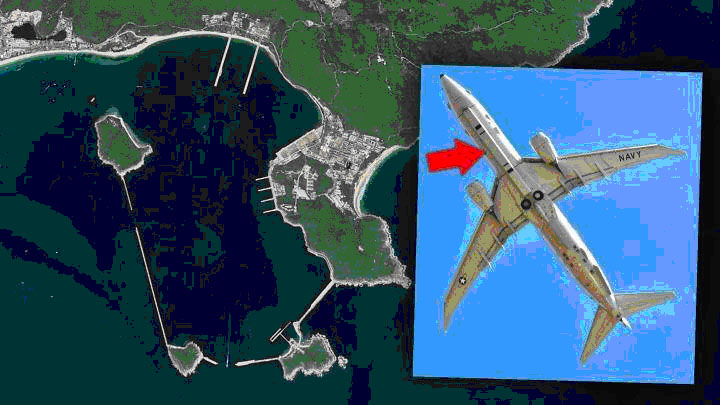Massive Chinese Naval Base In South China Sea – Navy P-8 With Secretive Radar Pod Surveilance
14 May, 2020
The flight comes amid escalating friction between China, the U.S. and various countries in the South China Sea, as well as Taiwan.
A U.S. Navy P-8A Poseidon maritime patrol aircraft flew a route close to China’s Hainan Island in the South China Sea, which is home to a massive People’s Liberation Army Navy base, earlier today. This particular aircraft is one of a small subset of the service’s Poseidon fleet that is configured to carry a shadowy radar system known as the AN/APS-154 Advanced Airborne Sensor.
On May 15, 2020, online plane spotter and Twitter user Golf9 spotted the P-8A, which carries the Navy Bureau Number 169010, flying a route through the South China Sea that took it around Hainan and into the Gulf of Tonkin. The Poseidon then turned around and exited the area along a similar path. The plane came within approximately 30 miles of the southern coast of the island, including passes by the sprawling Yulin Naval Base.
Golf9 also pointed out that 169010 is one of at least seven P-8As that have been observed carrying the AN/APS-154 in the past. The Advanced Airborne Sensor (AAS) is a large podded system that requires the installation of a special mount on the underside of the fuselage.
Raytheon developed the AN/APS-154 almost under a large degree of secrecy and its exact capabilities remain highly classified. The radar inside the pod is known to be an active electronically scanned array (AESA) type that can capture highly detailed imagery, even at night or in bad weather, while operating in a synthetic aperture mode and has a moving target indicator (MTI) functionality.
The AAS is also specifically designed to work in complex littoral regions and scan sea and land areas at the same time with extreme fidelity. Traditional surface search radars are generally configured to spot and track objects of interest in one of these environments or the other, or have dedicated modes for both, and have trouble functioning in both simultaneously. The Navy acquired the AN/APS-154 as a direct follow-on to the AN/APS-149 Littoral Surveillance Radar System (LSRS), an earlier and equally secretive Raytheon-developed podded radar that some of the service’s P-3C Orions carry. You can read more about the AN/APS-149 and the AN/APS-154 here.
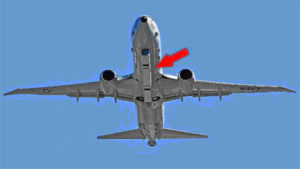
Another AAS-equipped P-8A, this one with Bureau Number 169007, with a red arrow pointing to the radar pod.
Hainan is exactly the kind of target area that the AN/APS-154 was designed to scan. The P-8As also have signals intelligence capabilities, which allow them to detect, geolocate, and classify emissions, including from radars and other air defense nodes, which can help in building a so-called “electronic order of battle” of a potential opponent’s defensive networks.
The island has long been an intelligence target for the U.S. military and the U.S. Intelligence Community. Notably, in April 2001, a Navy EP-3E Aries II spy plane made an emergency landing at Lingshui Airfield on the Island after suffering serious damage after a mid-air collision with a People’s Liberation Army Navy (PLAN) J-8II fighter jet. The Chinese jet was destroyed, killing the pilot, Lieutenant Commander Wang Wei, in what became a major international incident.
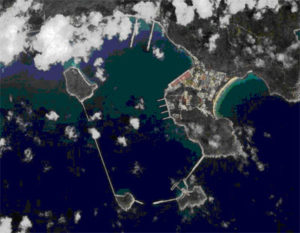
A satellie image of Yulin Naval Base on March 3, 2020.
The AAS-equipped P-8A on this latest flight past the island would certainly have been able to peer into Yulin with its underslung radar while flying a slanted flight path, as well as other potential areas of interest along the coast. One particular objective might have to gather information about the state of the People’s Liberation Army Navy’s growing Type 094 Jin class ballistic missile submarine fleet.

A Type 094 ballistic missile submarine.
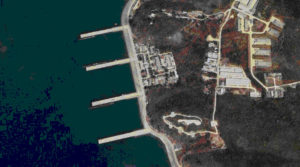
A pair of Type 094 ballistic missile submarines, as well as another submarine at the top, docked at Yulin on March 3.
There were reports in April that the PLAN had taken delivery of two more Type 094s, which, if true, would bring the total number of these submarines in service to six. In February, the Office of Naval Intelligence told members of Congress that China only commissioned four of these submarines so far, though it expected six ballistic missile submarines to be in Chinese service by 2025 and eight by 2030. This total could eventually include some number of new Type 096 ballistic missile submarines, a follow-on class to the Type 094 that is reportedly in development.

A table showing PLAN submarine force totals, according to the US Navy, as of February 2020. This came from a draft document that the Federation of American Scientists obtained via the Freedom of Information Act that did not include comparative totals and protections for the US Navy.
The Type 094s represent an important and expanding second-strike nuclear capability for China and, together with reported work on the H-20 stealth strategic bomber, is evidence that the country is moving closer to deploying a true deterrent triad of land, sea, and aerial delivery platforms. In addition, Chinese authorities just recently highlighted continued work on the JL-3 solid-fuel submarine-launched ballistic missile, development of which first began as a companion to the Type 096.
Yulin is a major base for the PLAN’s steadily larger and more modern submarine force, as well as its surface fleets, as well, and famously features a large network of underground facilities, including pens that submarines can sail in and out of directly.
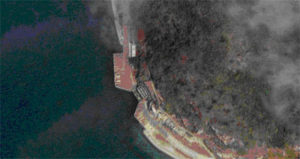
A close up of the entrance to the subterranean submarine cavern at Yulin.
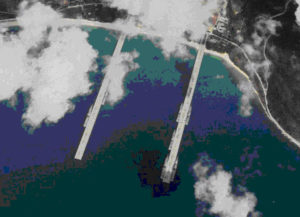
PLA Navy surface warships at Yulin.
The Chinese have also expanded military facilities above ground in the same general area, including around nearby Sanya Harbor, in recent years, notably adding a pier capable of accomodating the country’s growing fleet of aircraft carriers.
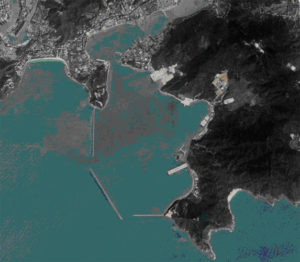
A satellite image of Sanya Harbor on March 3, 2020, with the large, rectangular carrier-capable pier seen toward the south end.
The flight of 169010 past Hainan also follows the apparent end of a dispute in the southern end of the South China Sea over the activities of the West Capella, a Panama-flagged drillship operating under contract to the Malaysian government to explore potential oil and natural gas resources in the area. Beijing has expansive claims over virtually the entire body of water, which every other country in the region, as well as the vast majority of the international community, rejects.
Chinese vessels reportedly harassed the West Cappella and supporting ships, starting in December, and China also sent its own survey vessel, the Haiyang Dizhi 8, from Hainan to conduct operations in the area with escorts from the Chinese Coast Guard and the country’s paramilitary Maritime Militia. Naval vessels from Vietnam, which also has territorial claims in the area, as well as the United States and Australia, conducted various patrols in the region, as well.
“The United States is concerned by reports of China’s repeated provocative actions aimed at the offshore oil and gas development of other claimant states,” the U.S. State Department said in a statement in April. “In this instance, [China] should cease its bullying behavior and refrain from engaging in this type of provocative and destabilizing activity.”
“There is no better signal of our support for a free and open Indo-Pacific than positive and persistent U.S. Naval engagement in this region,” U.S. Navy Rear Admiral Fred Kacher, Commander of Expeditionary Strike Group 7, headquartered in Japan, said after the Independence class littoral combat ship USS Gabrielle Giffords conducted a patrol near the West Capella on May 12. That same day, the drillship concluded its scheduled activities and left the area.
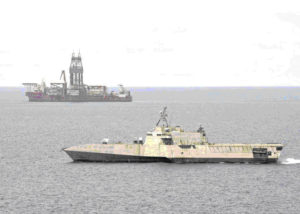
The Independence class littoral combat ship USS Gabrielle Giffords, in the foreground, sails past the drillship West Capella in the South China Sea on May 12.
This is just the latest instance of friction between China and other countries in the South China Sea region, as well as the United States. This has lead to direct confrontations between American and Chinese forces, including a near-collision between warships from the two countries in 2018.
On May 8, Air Force B-1 Bones also flew a mission to the South China Sea as part of a new dynamic concept of operations that involves irregular bomber sorties in both the Pacific region and Europe. These flights, some of which have involved round trips to and from bases in the United States, have become a regular occurrence following the recent and abrupt end of the Air Force’s Continuous Bomber Presence deployments on Guam after 16 years, which The War Zone was first to report.
In addition to these activities in the South China Sea, there has been an uptick in tensions between Beijing and authorities on the island of Taiwan ahead of the inauguration of Taiwanese President Tsai Ing Wen for her second term next week. The Chinese government, which treats Taiwan and a semi-autonomous region, has decried Tsai in the past as a pro-independence “extremist” and threatened military action repeatedly if the island seeks to formally break away from the mainland.
Tsai, who first took office around the same time as President Donald Trump, has cultivated close ties with the current U.S. President and his administration. The U.S. government does not officially recognize the government of Taiwan, but has established a framework to work with it and support its defense needs until such time as there is a formal resolution of its status.
The Trump Administration has concluded a number of arms deals with Taiwanese authorities in recent years, notably agreeing to deliver new advanced versions of the F-16 Viper fighter jet, which China has long said was a red line that would provoke a major response. There were unconfirmed reports recently that China might be preparing to invade Taiwan. Officials on the island have not said whether or not those news stories were accurate, but have said that they continue to closely monitor Chinese military activities. The People’s Liberation Army has recently kicked off major exercises, which certainly appears to be a signal aimed at Taiwan and follows a number of other similarly provocative maneuvers in recent months.
At the same time, U.S. naval vessels and military aircraft have conducted a number of so-called Freedom of Navigation patrols in the Strait of Taiwan in recent months, which are clearly meant to demonstrate America’s resolve to defend Taiwan against any Chinese aggression. Just this week, the Navy’s Arleigh Burke class destroyer USS McCampbell sailed through the Strait on one of these patrols.
In addition to their recent flights in the South China Sea, Air Force B-1 bombers have flown a number of recent missions into the East China Sea to the north of Taiwan, in which China also has territorial disputes with Japan and South Korea.
With all this going on, while we don’t know exactly what 169010 and its AN/APS-154 radar were looking at specifically, it’s hardly surprising that the Navy sent it to go check on what might be happening at one of China’s most strategic naval bases. The AAS offers the Navy a powerful new intelligence-gathering tool and it seems likely that we will now be seeing more of the P-8As equipped with these secretive sensors, especially in the Pacific region.
Courtesy: Opera News/ thedrive.com

